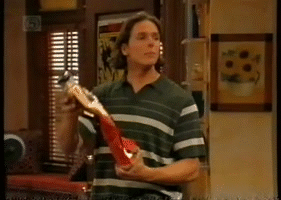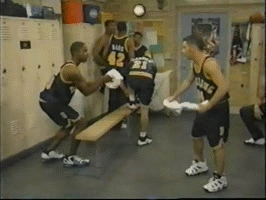Post by sbtbfanatic on Dec 9, 2013 11:42:11 GMT
“The Seinfeld Chronicles” (Pilot)
First script read: April 20, 1989
Filmed: April 27, 1989
Aired: July 5, 1989, 9:30 pm
Nielsen Rating: 10.9
Audience Share: 19
Directed by: Art Wolff
Written by: Larry David and Jerry Seinfeld
How do people communicate? Ideally, with words. In his stand-up, presented in the pilot as something of a release for Jerry from the stresses encountered in the world, Jerry crafts words into comedy to take a frank look at society.
But in many situations society doesn't tolerate frankness. Politeness demands tact and restraint bounded by a generally unstated system of social etiquette. Because it is unstated, proper social etiquette is often a mystery. Luckily, in George (and as the series progresses, in Elaine and Kramer), Jerry has a friend who sees the world fairly similarly and who he is intimate enough with that he feels he can have frank discussions about social behavior
In this case, a woman, Laura, whom Jerry met a while back, calls him out of the blue to let him know she is going to be in town. Jerry is interested in Laura, but he and George wonder whether she is interested in him. They discuss the words and voice inflection of her call. When she calls again and asks to stay in Jerry's apartment, they debate whether this request is a "signal" that Laura is expecting to have sex with Jerry. George goes with Jerry to the airport. There they try but fail to gauge her interest in Jerry by her greeting.
As Larry David and Jerry Seinfeld's first crack at a sitcom, the Seinfeld Pilot is rough and far from hilarious. However, the Pilot pulls off a nice trick in simultaneously building both the sexual tension and the comedic tension to the climax when Jerry and the audience discover Laura's intentions. Once in Jerry's apartment Laura sends signal after signal to Jerry that she is interested in sex. She kicks off her shoes, unbuttons her top blouse button, asks for a glass of wine, and turns down the light. Jerry is about to make a move when the phone rings. The call is for Laura, who speaks cheerfully and fairly intimately for a few moments. She hangs up and reveals...it was her fiancee.
Smash-cut to..."I have absolutely no idea what women are thinking," Jerry admits in the last of four standup acts interspersed in the Pilot. The main plot of the episode is about the timeless problem of trying to understand the opposite sex. But non-verbal communication problems transcend gender in this episode. Kramer (called Kessler in this episode only) visits Jerry at 1:00am. Despite Jerry's annoyed body language and repeated eye-rolling, Kramer makes himself at home with a bowl of cereal on the couch. Jerry could ask him to leave, but that wouldn't be polite.
From his first moments on the series it is clear that Kramer is strange, by which I mean his behavior varies from the unspoken cultural expectations to an extreme degree. From the Pilot, Seinfeld's humor (as well as Jerry Seinfeld's stand-up humor) addresses those unspoken areas in society, revealing their absurdity through the awkwardness of both "normal" people (Jerry and Laura) and more or less "abnormal" characters (many would join Kramer in this category over the series' run).
First script read: April 20, 1989
Filmed: April 27, 1989
Aired: July 5, 1989, 9:30 pm
Nielsen Rating: 10.9
Audience Share: 19
Directed by: Art Wolff
Written by: Larry David and Jerry Seinfeld
How do people communicate? Ideally, with words. In his stand-up, presented in the pilot as something of a release for Jerry from the stresses encountered in the world, Jerry crafts words into comedy to take a frank look at society.
But in many situations society doesn't tolerate frankness. Politeness demands tact and restraint bounded by a generally unstated system of social etiquette. Because it is unstated, proper social etiquette is often a mystery. Luckily, in George (and as the series progresses, in Elaine and Kramer), Jerry has a friend who sees the world fairly similarly and who he is intimate enough with that he feels he can have frank discussions about social behavior
In this case, a woman, Laura, whom Jerry met a while back, calls him out of the blue to let him know she is going to be in town. Jerry is interested in Laura, but he and George wonder whether she is interested in him. They discuss the words and voice inflection of her call. When she calls again and asks to stay in Jerry's apartment, they debate whether this request is a "signal" that Laura is expecting to have sex with Jerry. George goes with Jerry to the airport. There they try but fail to gauge her interest in Jerry by her greeting.
As Larry David and Jerry Seinfeld's first crack at a sitcom, the Seinfeld Pilot is rough and far from hilarious. However, the Pilot pulls off a nice trick in simultaneously building both the sexual tension and the comedic tension to the climax when Jerry and the audience discover Laura's intentions. Once in Jerry's apartment Laura sends signal after signal to Jerry that she is interested in sex. She kicks off her shoes, unbuttons her top blouse button, asks for a glass of wine, and turns down the light. Jerry is about to make a move when the phone rings. The call is for Laura, who speaks cheerfully and fairly intimately for a few moments. She hangs up and reveals...it was her fiancee.
Smash-cut to..."I have absolutely no idea what women are thinking," Jerry admits in the last of four standup acts interspersed in the Pilot. The main plot of the episode is about the timeless problem of trying to understand the opposite sex. But non-verbal communication problems transcend gender in this episode. Kramer (called Kessler in this episode only) visits Jerry at 1:00am. Despite Jerry's annoyed body language and repeated eye-rolling, Kramer makes himself at home with a bowl of cereal on the couch. Jerry could ask him to leave, but that wouldn't be polite.
From his first moments on the series it is clear that Kramer is strange, by which I mean his behavior varies from the unspoken cultural expectations to an extreme degree. From the Pilot, Seinfeld's humor (as well as Jerry Seinfeld's stand-up humor) addresses those unspoken areas in society, revealing their absurdity through the awkwardness of both "normal" people (Jerry and Laura) and more or less "abnormal" characters (many would join Kramer in this category over the series' run).


